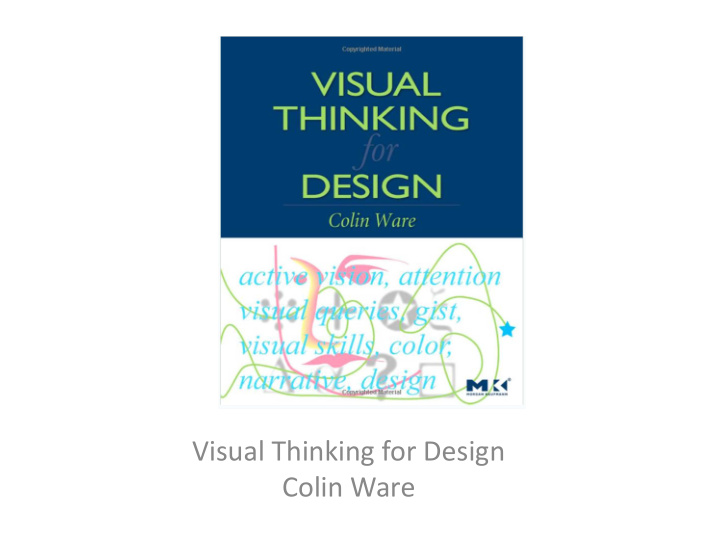



Visual Thinking for Design Colin Ware
How much do we see? • We do not have the entire visual world in conscious awareness • We apprehend only a tiny fraction of information in our surrounding – Just the right amount of information Simons and Levin’s experiment
The Door Study • https://youtu.be/FWSxSQsspiQ
The Selection Attention Test • https://youtu.be/vJG698U2Mvo
What do you see in this pic?
X B (Cover your left eye , look at X, move your head back and forward ) Do you find B disappear at some point?
The Apparatus Eye – digital camera • Light sensitive cones – three • colors Brain pixels are concentrated • in a central region called fovea to process visual detail (100 pts on the top of a pin) Half of our visual brain is to • process about 5 % of the visual world Eyeball muscle moves about • 900 degree/second (saccade)
The Apparatus Eye – digital camera • Light sensitive cones – three • colors Brain pixels are concentrated • in a central region called fovea to process visual detail (100 pts on the top of a pin) Half of our visual brain is to • process about 5 % of the visual world Eyeball muscle moves about • 900 degree/second (saccade)
The Apparatus Eye – digital camera • Light sensitive cones – three • colors Brain pixels are concentrated • in a central region called fovea to process visual detail (100 pts on the top of a pin) Half of our visual brain is to • process about 5 % of the visual world Eyeball muscle moves about • 900 degree/second (saccade)
How much do we see? • We do not have the entire visual world in conscious awareness • We apprehend only a tiny fraction of information in our surrounding – Just the right amount of information • But we can sample the world around us very rapidly with swift eye movement (900 degrees /second and stop in 1/10 second) – Although we have very little attention capacity. Unimportant things are discarded • A good use of our cognition ability is very important to keep our brain small – To see only what we attend to and only attend to what we see
Visual Thinking and Queries • Visual thinking – the process of allocating attention • Visual thinking consists of a series of acts of attention, driving eye movements and turning our pattern finding circuits • The act of attention is called visual query – search for pattern • We are conscious of the field of information that we have rapid access rather than the entire world – Being aware of this allows us to do a better graphics design
Visual Thinking and Queries
The Act of Perception • Two waves of neural activity – Information driven wave – Attention driven wave • Bottom up and top down perception
The Act of Perception • Two waves of neural activity – Information driven wave – Attention driven wave • Bottom up and top down perception
The Act of Perception • Two waves of neural activity – Information driven wave – Attention driven wave • Bottom up and top down perception
Bottom Up Perception • Low level features –> pattern –> object – Optical nerve – V1 cortex : feature detection edges and contours; color; motion; – Features are put together to form patterns – textures, long contours, (Gelstat psychology) – Visual objects (three in visual working memory at a time) • This is why we need external visual aids – Not all visual processing is done in visual working memory • They are done in parallel by many parts instead – The real power lies in pattern finding
The Act of Perception • Top-down (attention) – Driven by the need to accomplish some goals – Search for a color then the color feature will be enhanced – Eye movement: fast at first, fixation was brief, – How does our brain know where to look? Rough map first and then detail searching
Design Implication • The design should allow visual queries to be processed rapidly and correctly for the cognitive tasks that the display is intended to support – Understand the intended cognitive tasks and visual queries What are the cognitive tasks?
How We Solve Problems? • Nested Loops – Outer loop deals with generality (construct a set of steps to solve the problem) – Inner loops deal with details (visual search, eye movement, find patterns, etc.)
Recommend
More recommend